How to Grow Sage Plant: Tips for Thriving Herb Gardens
- April 1, 2024
- 0 comment
Learn how to grow Sage plant (Salvia officinalis), a versatile herb for cooking and health, with this step-by-step guide. Discover how to cultivate and care for sage plants, a favorite for its hardy nature and aromatic leaves.
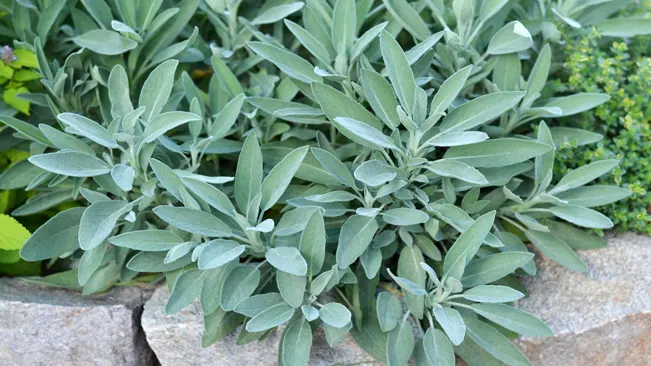
Benefits of Sage Plant
| Benefit | Description |
|---|---|
| Culinary Uses | Widely used in cooking for its aromatic flavor. Ideal in stuffings, meats, sauces, and teas. |
| Medicinal Properties | Believed to have various health benefits such as improving brain function, lowering blood sugar levels, and reducing cholesterol. |
| Antioxidant Effects | Contains high levels of antioxidants which help in protecting the body’s cells from damage by free radicals. |
| Anti-inflammatory Properties | May help in reducing inflammation and relieving pain, beneficial in conditions like arthritis. |
| Oral Health | Used in dental products for its antibacterial properties, which can help in maintaining oral health and preventing dental plaques. |
| Menopausal Symptom Relief | Contains compounds that may alleviate menopausal symptoms like hot flashes and sweating. |
| Skin Health | Sage oil and extracts are used in skincare products for their potential to improve skin health, reduce signs of aging, and treat conditions like eczema and acne. |
| Digestive Aid | Herbal teas made with sage can aid digestion and alleviate issues like bloating, gas, and stomach pain. |
| Microbial and Fungal Resistance | Exhibits antimicrobial properties, making it effective against various bacteria, viruses, and fungi. |
| Cognitive Boost and Mood Enhancement | Some studies suggest that sage can enhance cognitive function and may also help in elevating mood and relieving symptoms of depression. |
List of How to Grow Sage Plant
- Selecting the Right Variety
- Starting Your Sage Plants
- Choosing the Right Location
- Soil and Fertilization
- Planting
- Watering and Care
- Pests and Diseases
- Harvesting
- Winter Care
- Uses of Sage
Selecting the Right Variety
Before you start, decide which variety of sage suits your needs. Common sage is most widely used for cooking, while other varieties, like pineapple sage, are grown for their scented leaves and attractive flowers.
Common Sage (Salvia officinalis)

- This is the most widely grown type of sage, known for its strong herbal flavor. It’s ideal for culinary uses, particularly in dishes like stuffing, sausages, and sauces. Common sage has grayish-green leaves and can also be used for decorative purposes.
Pineapple Sage (Salvia elegans)
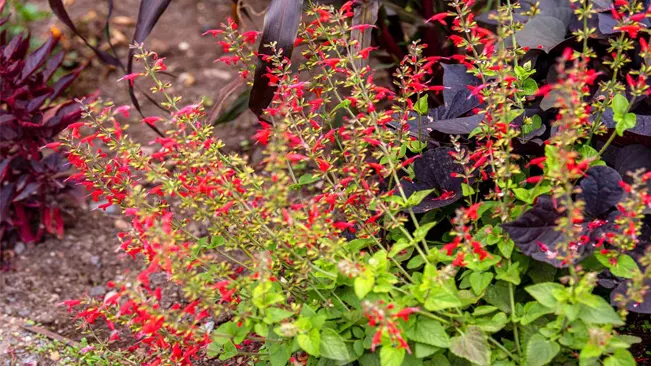
- Named for its pineapple-scented leaves, this variety is more commonly used for its fragrance than for cooking. It produces bright red flowers in late summer or fall, attracting hummingbirds and butterflies. Pineapple sage is great in teas and as a garnish for summer dishes.
Purple Sage (Salvia officinalis ‘Purpurascens’)
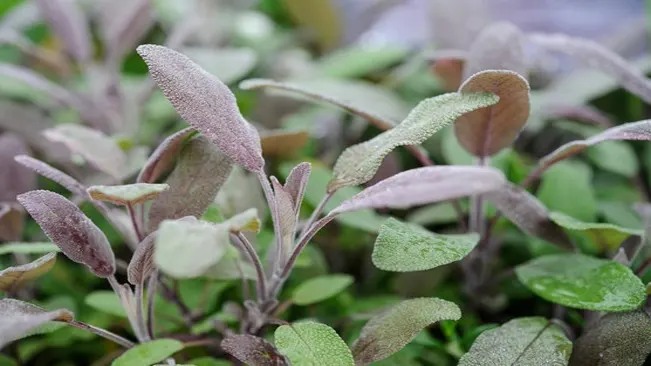
- This variety is visually striking with its purplish leaves, adding color to both your garden and your dishes. It has a similar flavor to common sage but is milder, making it suitable for a variety of culinary uses.
Tricolor Sage (Salvia officinalis ‘Tricolor’)
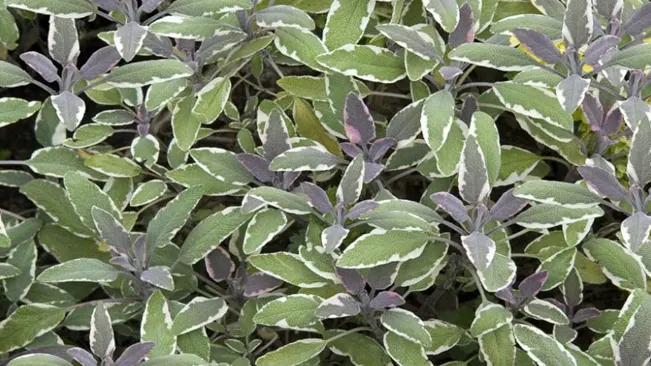
- As the name suggests, this sage variety has leaves with three colors: green, white, and pink. While it’s not as robust in flavor as common sage, it’s highly decorative and can be used in cooking for a milder sage taste.
Golden Sage (Salvia officinalis ‘Icterina’)
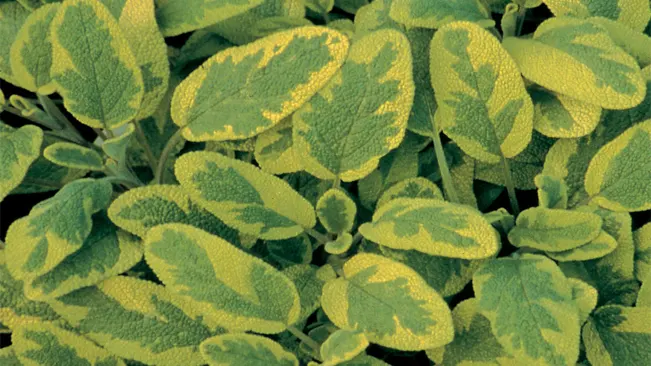
- Golden sage has variegated leaves with green centers and golden-yellow edges. It’s similar in flavor to common sage but adds a unique visual appeal to both gardens and dishes.
Greek Sage (Salvia fruticosa)
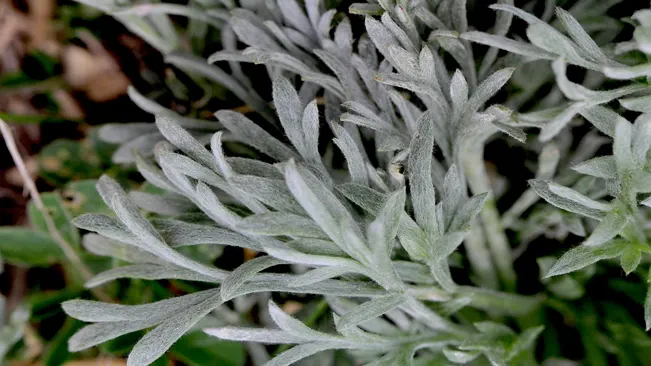
- A variety often found in the Mediterranean, Greek sage has a slightly different flavor profile compared to common sage. It’s known for its potent aroma and is commonly used in Greek cuisine.
White Sage (Salvia apiana)
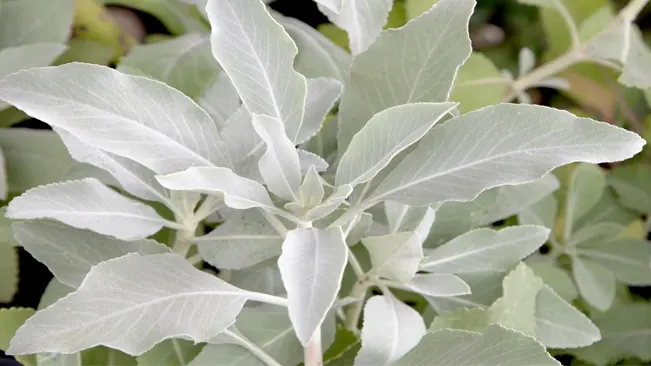
- Primarily known for its uses in rituals and smudging for its strong aromatic properties. It’s not typically used for cooking but is sought after for its spiritual and cleansing purposes.
Clary Sage (Salvia sclarea)
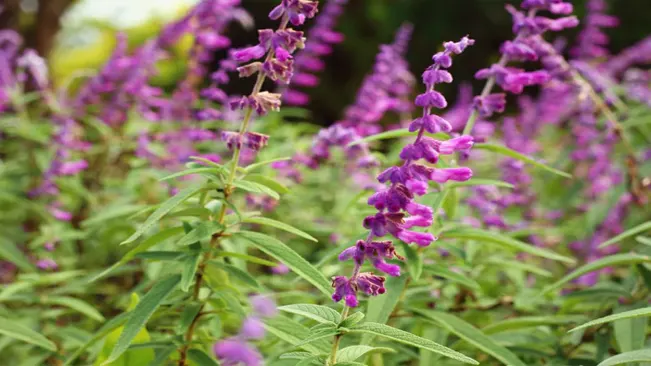
- Although it’s not typically used in cooking, clary sage is known for its medicinal properties and is widely used in aromatherapy and natural medicine. It has large, hairy leaves and tall spikes of flowers.
Starting Your Sage Plants
You can begin sage from seeds, cuttings, or seedlings. Starting from seedlings or cuttings is generally easier as sage seeds can be slow to germinate.
Starting Sage from Seeds
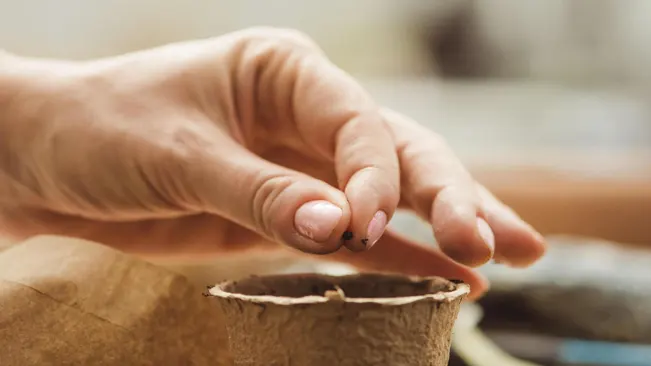
- Timing: Begin 6-8 weeks before the last expected frost date. This head start is crucial because sage seeds take longer to germinate and grow slower than many other herbs.
- Seed Selection: Choose high-quality seeds from a reputable supplier to ensure good germination rates.
- Soil Preparation: Use a sterile seed starting mix, which is lighter and more conducive to germination than regular potting soil.
- Sowing the Seeds: Plant the seeds about 1/4 inch deep in the soil. Sage seeds need some light to germinate, so don’t bury them too deep.
- Moisture and Temperature: Keep the soil consistently moist but not waterlogged. A temperature of around 70°F (21°C) is ideal for germination.
- Light: Provide plenty of light. A sunny windowsill or grow light can help ensure the seedlings don’t become leggy.
- Transplanting: Once the seedlings have a few sets of true leaves and are sturdy enough, transplant them to their final location or larger pots.
Starting Sage from Cuttings
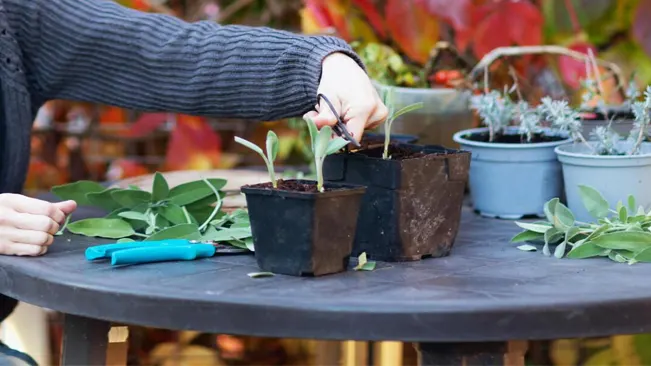
- Best Time: Take cuttings from an existing sage plant in late spring or early summer.
- Cutting Selection: Choose healthy, non-flowering stems. Cut about 4-6 inches from the tip, ensuring there are several leaf nodes on the cutting.
- Preparing the Cutting: Remove the leaves from the lower half of the cutting to expose the nodes, as roots will develop from these points.
- Rooting Medium: Plant the cutting in a pot filled with a mix of potting soil and perlite or sand to improve drainage.
- Moisture and Humidity: Keep the soil moist, and you can cover the pot with a plastic bag or use a propagator to maintain humidity, which aids in rooting.
- Root Development: Roots generally begin to form within a few weeks. Once the cuttings have developed a good root system, they can be transplanted either into the ground or larger pots.
Choosing the Right Location
Sage thrives in full sunlight and well-drained soil. Ensure the planting site gets at least six hours of sunlight daily. In hot climates, afternoon shade can prevent the plant from wilting.

Sunlight Requirements
- Full Sunlight: Sage requires full sunlight, meaning at least six hours of direct sun exposure each day. This sunlight is crucial for the plant to develop its full flavor and aromatic oils. Inadequate sunlight can lead to leggy plants with weak growth and less flavor.
- Intensity and Duration: The quality of sunlight is also important. In regions with intense sun, such as desert climates, the afternoon sun can be too harsh. Conversely, in cooler climates, maximizing sunlight exposure is vital for healthy growth.
Soil Quality and Drainage
- Well-Drained Soil: Sage prefers well-drained soil, as waterlogged roots can lead to root rot, a common problem in sage cultivation. The soil should allow water to pass through easily while retaining enough moisture to support plant growth.
- Soil Composition: Loamy or sandy soils are typically well-suited for sage. If your garden has heavy clay soil, consider amending it with sand or organic matter to improve drainage. Alternatively, raised beds or containers can be excellent options.
Considering Climate and Microclimates
- Hot Climates: In hot climates, sage can benefit from afternoon shade. This helps prevent the plant from wilting under excessive heat. Planting near a structure or larger plant that provides partial afternoon shade can be beneficial.
- Cold Climates: In colder regions, a south-facing location that maximizes sun exposure helps sage survive chilly temperatures. Also, protecting the plant with mulch in winter can be advantageous.
Elevation and Air Circulation
- Elevation: Positioning sage plants slightly elevated (such as on a slope or in raised beds) can improve drainage, reducing the risk of root diseases.
- Air Circulation: Good air circulation around sage plants is crucial. It helps prevent fungal diseases like powdery mildew. Avoid overcrowding and ensure each plant has enough space.
Accessibility and Aesthetics
- Easy Access: Plant sage in an accessible spot, especially if you plan to use it regularly in cooking. Having it near your kitchen or in a herb garden can be convenient.
- Aesthetic Value: Sage plants, with their greyish-green leaves and sometimes colorful flowers, can be both functional and decorative. Consider their visual contribution to your garden when deciding on their location.
Soil and Fertilization
Sage prefers slightly acidic to neutral soil (pH 6.0 to 7.0). Improve your soil by adding organic matter if needed. Over-fertilizing can diminish the plant’s flavor, so use compost or a balanced, slow-release fertilizer sparingly.
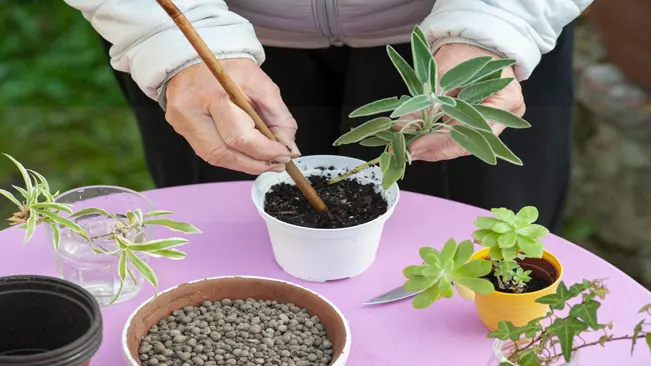
Soil Requirements for Sage
- pH Level: Sage thrives in a pH range of 6.0 to 7.0, which is slightly acidic to neutral. The pH level of the soil affects nutrient availability, and maintaining it within this range ensures the sage plant can absorb nutrients efficiently.
- Soil Texture: Well-draining soil is crucial for sage. This herb does not like to sit in wet soil as it can lead to root rot. Loamy or sandy soils are ideal as they provide good drainage.
- Soil Quality Improvement:
- Organic Matter: Incorporating organic matter like compost or aged manure into the soil can improve its texture and nutrient content. This addition also enhances the soil’s ability to retain moisture while still providing good drainage.
- Aeration: If the soil is too compact, mixing in some perlite or coarse sand can help aerate it, promoting better root growth and drainage.
- Testing Soil pH: It’s advisable to test your soil’s pH before planting. If the pH is too high (alkaline), you can lower it by adding sulfur or peat moss. If it’s too low (acidic), applying lime can help raise the pH.
Fertilization of Sage
- Fertilization Needs: Sage is not a heavy feeder. In fact, too much fertilizer, especially high-nitrogen fertilizers, can lead to lush foliage with diminished flavor and aroma.
- Type of Fertilizer:
- Compost: Applying a thin layer of compost around the base of the plant can provide slow-release nutrients throughout the growing season.
- Balanced Fertilizer: If using commercial fertilizers, opt for a balanced, slow-release type. Balanced fertilizers have equal parts of nitrogen, phosphorus, and potassium (e.g., 10-10-10).
- Application Frequency: Fertilize sage sparingly, only once or twice during the growing season. Over-fertilizing can lead to rapid growth at the expense of the essential oils that give sage its flavor and aroma.
- Signs of Over-Fertilization: If the sage plant is growing very quickly and has lush, green growth but little aroma, it may be a sign of too much fertilizer.
Planting
Spacing Sage Plants
- The recommendation to space sage plants about 18 to 24 inches apart is crucial for several reasons. Firstly, it ensures that each sage plant has enough room to grow and spread without competing for resources like nutrients, water, and sunlight. Secondly, adequate spacing promotes good air circulation around each plant, which is essential in preventing fungal diseases like powdery mildew. This spacing also makes it easier for you to access the plants for pruning, harvesting, and general care.
Planting Depth
- When planting sage, it’s important to maintain the same depth as they were in their nursery pot. This means the base of the plant, where the stems emerge from the roots, should be at soil level. Planting too deep can cause the stems to rot, while planting too shallow can expose the roots to air and sun, stressing the plant. Maintaining the correct depth helps ensure the plant’s roots are properly anchored and can access the moisture and nutrients they need to establish themselves.
Watering and Care
Sage doesn’t require a lot of water. Allow the soil to dry out between watering. Overwatering can lead to root rot. Pruning is essential to encourage growth and prevent woody stems. After flowering, cut back the plant to promote new, flavorful leaves.
Watering Sage
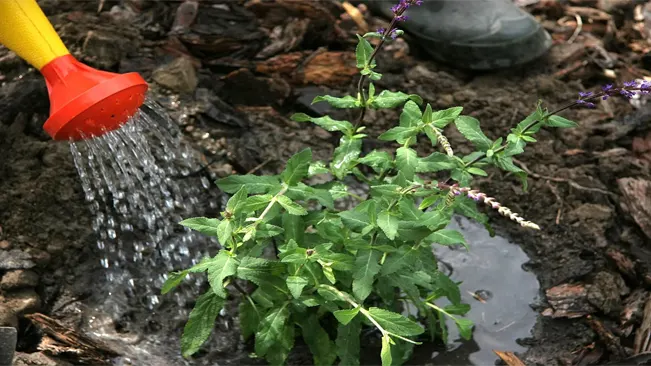
- Moderation is Key: Sage is drought-tolerant once established, which means it requires less water compared to other herbs. The key is to water deeply but infrequently.
- Checking Soil Moisture: Before watering, check the soil moisture. You can do this by sticking your finger an inch into the soil. If it feels dry, it’s time to water.
- Watering Technique: When watering, do so at the base of the plant to avoid wetting the leaves, which can lead to fungal diseases. Use a drip irrigation system or a soaker hose for the best results.
- Seasonal Adjustments: Reduce watering in the cooler months, as the plant’s water requirements decrease with lower temperatures and reduced sunlight.
Pruning and Care of Sage
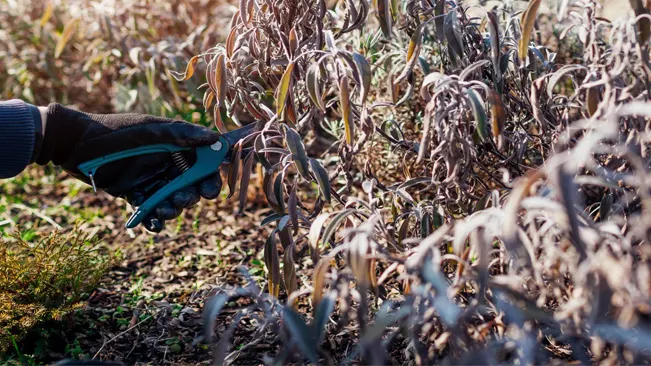
- Regular Pruning: Regular pruning is crucial for maintaining a healthy, bushy sage plant. Prune lightly in the spring to remove any dead or damaged leaves and promote new growth.
- Pruning Post-Flowering: After the sage blooms, it’s a good time to prune heavily. This encourages the plant to produce new, flavorful leaves and prevents it from becoming leggy and woody.
- Method of Pruning: Use clean, sharp shears, and make cuts just above a leaf node (where leaves join the stem). This will encourage the plant to branch out.
- Preventing Woody Growth: Regularly harvesting leaves can also help prevent the center of the plant from becoming woody. It’s recommended to start harvesting leaves from the top and outer portions of the plant.
- Annual Pruning: In late winter or early spring, before new growth starts, cut back the sage plant to about a third of its size to revitalize it and encourage lush new growth.
- Fertilizing Needs: Sage doesn’t need much fertilizer. However, if the growth seems slow, you can apply a light, balanced fertilizer in spring.
- Avoiding Overcrowding: Ensure sage plants have enough space for air circulation. This reduces the risk of fungal diseases, which sage can be prone to in humid or overly wet conditions.
Pests and Diseases
Sage is relatively pest-resistant. However, watch out for slugs, spider mites, and mildew. Regular inspection and proper air circulation around plants can prevent most issues.
Pests
- Slugs and Snails: These pests are attracted to the moisture and tender leaves of sage. They leave irregular holes in the leaves and slimy trails. Management includes hand-picking, setting up barriers like diatomaceous earth, or using slug baits.
- Spider Mites: These tiny pests suck sap from the leaves, causing them to look speckled and eventually turn yellow and drop off. They thrive in hot, dry conditions. Increasing humidity and using insecticidal soaps or neem oil can help control them.
- Aphids: Small, soft-bodied insects that cluster on new growth and undersides of leaves, aphids can cause leaf curling and stunted growth. They also excrete a sticky substance called honeydew which can lead to sooty mold. Spraying with water or using insecticidal soaps can be effective.
Diseases
- Powdery Mildew: This fungal disease appears as white, powdery spots on leaves and stems. It’s more common in humid or crowded conditions. Ensure good air circulation, avoid overhead watering, and use fungicides if necessary.
- Root Rot: Overwatering can lead to root rot, where the roots of the sage plant start decaying. This is indicated by wilting and yellowing of leaves. The key to prevention is ensuring well-draining soil and not overwatering.
- Downy Mildew: Similar to powdery mildew, downy mildew presents as yellowing leaves with fuzzy, grey mold on the undersides. It thrives in wet conditions. Reducing humidity and improving air circulation are essential for control.
Harvesting
Harvest sage leaves as needed. The best time to harvest is in the morning after the dew has dried. Harvesting before the plant flowers will ensure the most flavorful leaves.
Best Time for Harvesting

- The optimal time for harvesting sage leaves is in the morning after the dew has dried. During this time, the essential oils in the leaves, responsible for flavor and aroma, are at their peak, making the leaves more flavorful and aromatic.
Frequency of Harvesting
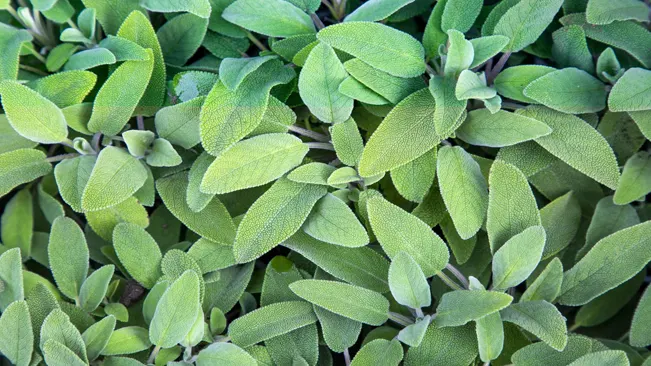
- Sage can be harvested as needed. It’s a hardy plant, and regular harvesting can actually encourage new growth and prevent the plant from becoming woody. However, it’s important not to over-harvest; generally, it’s advised not to take more than one-third of the plant at a time.
Harvesting Before Flowering
- For the best flavor, harvest sage leaves before the plant flowers. Once sage begins to flower, the energy of the plant shifts towards flower and seed production, which can change the flavor of the leaves, often making them more bitter.
Method of Harvesting
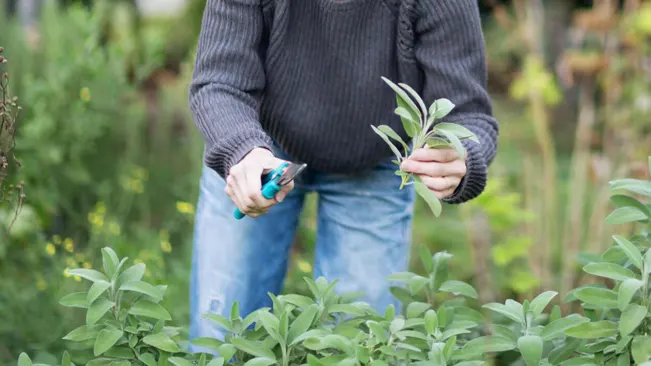
- To harvest, use clean, sharp scissors or garden shears. Cut the leafy stems, leaving a few inches of growth on the plant. This ensures the plant remains healthy and has enough foliage to continue growing.
Post-Harvest Care
- After harvesting, if you’re not using the sage leaves immediately, they can be stored for later use. Fresh sage leaves can be kept in the refrigerator for several days. Wrap them in a slightly damp paper towel and place them inside a plastic bag.
Regrowth After Harvesting
- Sage is a resilient plant. With proper care, it will regrow after harvesting, providing you with fresh leaves throughout its growing season, which is typically from spring to fall.
Harvesting for Seed Collection
- If you wish to collect seeds from your sage plant, let some of the flowers develop fully and go to seed. Once the seed pods are dry, you can collect the seeds for future planting.
Winter Care
Sage, being a Mediterranean herb, prefers warmer climates and might struggle in very cold conditions. However, with proper care, it can survive winter even in colder regions.
- Mulching: One of the simplest yet most effective methods to protect your sage plant in winter is mulching. Applying a thick layer of mulch around the base of the plant serves multiple purposes:
- Insulation: Mulch acts as an insulator, keeping the soil and roots warmer than the surrounding air temperature.
- Moisture Retention: It helps retain soil moisture, reducing the need for watering in the cold season.
- Weed Control: Mulch also suppresses weed growth, which can compete with your sage for nutrients.
- Container Gardening: In regions where temperatures drop significantly below freezing, consider growing sage in containers. This approach has several advantages:
- Mobility: Containers can be easily moved to sheltered locations like a garage or porch during extreme cold spells.
- Controlled Environment: Growing in containers allows for better control over the soil quality and moisture levels, important factors in winter care.
- Indoor Gardening: If you have a sunny window, you can bring sage indoors for the winter. This not only protects it from the cold but also provides fresh herbs throughout the season.
- Pruning: Before the onset of winter, prune your sage plant. This helps in two ways:
- Removes Dead Growth: Pruning off dead and woody stems helps prevent disease and pest infestation.
- Encourages Spring Growth: It promotes healthier and more vigorous growth when spring arrives.
- Watering Needs: During winter, sage’s water requirements decrease significantly. Water only when the soil is dry to the touch, and be sure to avoid waterlogging, especially in container-grown sage.
- Protection from Frost: On nights when a frost is expected, cover your sage plants with a frost cloth or burlap to shield them from the cold. Remove the cover during the day to allow air circulation and prevent overheating.
- Monitoring for Pests and Diseases: Regularly check your sage plants for signs of pests or diseases, which can be more prevalent in the damp and cold conditions of winter.
Uses of Sage
Apart from its culinary use in stuffings, sausages, and sauces, sage has medicinal properties and is also used in teas. Its attractive flowers make it a good choice for ornamental gardens as well.
Culinary Applications

- Herbal Seasoning: Sage is a staple in many kitchens, especially in Mediterranean cuisine. It imparts a robust, slightly peppery flavor, making it ideal for seasoning meats like pork and poultry, and in dishes like casseroles and soups.
- Sauces and Butters: It’s often used to flavor butters and sauces, adding a depth of flavor to pasta dishes and breads.
- Stuffings and Sausages: Sage’s bold flavor complements the richness of stuffings and sausages, often used in traditional Thanksgiving stuffing and various sausage recipes.
Medicinal Properties
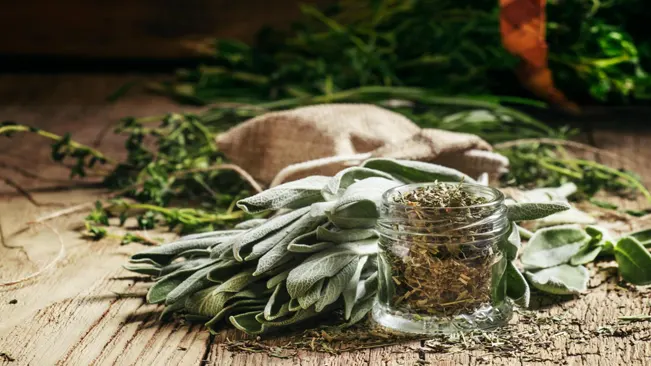
- Cognitive Benefits: Research suggests that sage may have cognitive-enhancing properties, potentially benefiting memory and concentration.
- Menopausal Relief: Certain compounds in sage are believed to offer relief from menopausal symptoms like hot flashes and night sweats.
- Antioxidant and Anti-inflammatory: Sage contains antioxidants and anti-inflammatory compounds, which can help protect the body from oxidative stress and reduce inflammation.
- Digestive Health: Sage tea is commonly used as a digestive aid, helping to relieve issues like indigestion and bloating.
Tea Preparation
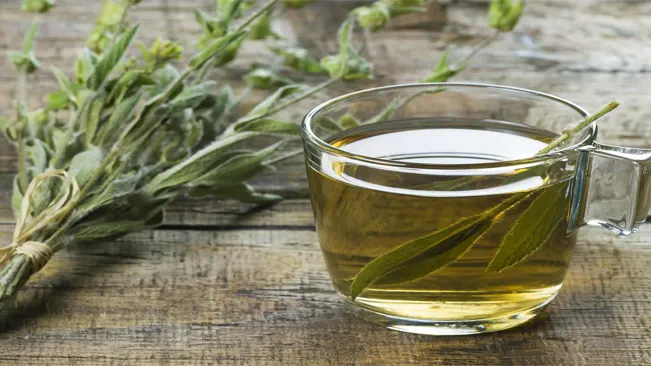
- Herbal Tea: Dried or fresh sage leaves can be used to make an aromatic herbal tea, known for its soothing properties and potential health benefits.
Ornamental Uses
- Garden Aesthetic: Sage plants, with their gray-green leaves and attractive flowers, are a popular choice for ornamental gardens. They provide visual interest and attract pollinators like bees and butterflies.
- Container Gardening: Sage is also suitable for container gardening, adding an aromatic and aesthetic element to balconies and patios.
Aromatherapy and Cosmetics
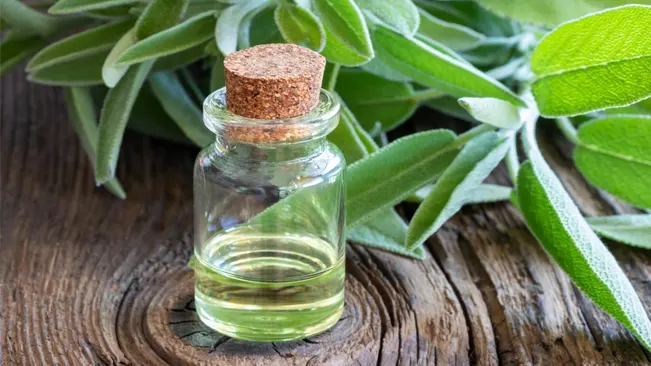
- Essential Oils: Sage essential oil is used in aromatherapy for its purported calming and clarifying properties.
- Skincare Products: In cosmetics, sage extracts are often added to skincare products for their antioxidant properties, which may help in skin rejuvenation and health.
Traditional and Cultural Uses
- Ceremonial Purposes: In some cultures, sage is used in smudging ceremonies for its supposed cleansing and purifying properties.
- Historical Remedies: Historically, sage was used in various traditional medicines for treating ailments like wounds, infections, and sore throats.
Preservation and Storage
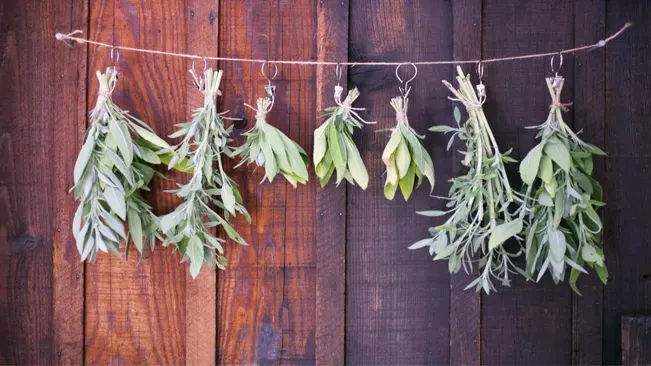
- Drying and Freezing: To preserve sage, leaves can be dried or frozen, allowing you to use them throughout the year.
Related Post:
Conclusion
Growing sage can be a rewarding experience for any gardener. This hardy herb not only adds flavor to your meals but also brings beauty and fragrance to your garden. With the right care, your sage plants will thrive and provide you with fresh leaves for years to come.
FAQs (Frequently Asked Questions)
- What is the best time to plant sage?
- Plant sage in the spring after the danger of frost has passed, ensuring it has plenty of time to establish itself before winter.
- Plant sage in the spring after the danger of frost has passed, ensuring it has plenty of time to establish itself before winter.
- How much sun does sage need?
- Sage thrives in full sun, requiring at least six hours of direct sunlight each day. In extremely hot climates, some afternoon shade can be beneficial.
- Sage thrives in full sun, requiring at least six hours of direct sunlight each day. In extremely hot climates, some afternoon shade can be beneficial.
- What type of soil is best for sage?
- Sage prefers well-drained soil with a slightly acidic to neutral pH (around 6.0 to 7.0). Adding organic matter can improve soil quality.
- Sage prefers well-drained soil with a slightly acidic to neutral pH (around 6.0 to 7.0). Adding organic matter can improve soil quality.
- How often should I water sage?
- Water sage plants deeply but infrequently, allowing the soil to dry out between watering. Overwatering can lead to root rot.
- Water sage plants deeply but infrequently, allowing the soil to dry out between watering. Overwatering can lead to root rot.
- Does sage need a lot of fertilizer?
- Sage does not require a lot of fertilization. Over-fertilizing can reduce its flavor. Use compost or a balanced, slow-release fertilizer sparingly.
- Sage does not require a lot of fertilization. Over-fertilizing can reduce its flavor. Use compost or a balanced, slow-release fertilizer sparingly.
- How do I propagate sage?
- Sage can be propagated from seeds, cuttings, or divisions. Taking cuttings or dividing established plants in the spring is often more successful than starting from seeds.
- Sage can be propagated from seeds, cuttings, or divisions. Taking cuttings or dividing established plants in the spring is often more successful than starting from seeds.
- When and how should I prune sage?
- Prune sage in the spring to remove any dead or woody stems and encourage new growth. Regular trimming throughout the growing season helps maintain a bushy, healthy plant.
- Prune sage in the spring to remove any dead or woody stems and encourage new growth. Regular trimming throughout the growing season helps maintain a bushy, healthy plant.
- How do I harvest sage?
- Harvest sage leaves as needed, cutting them in the morning when their flavor is most potent. Avoid harvesting more than one-third of the plant at a time.
- Harvest sage leaves as needed, cutting them in the morning when their flavor is most potent. Avoid harvesting more than one-third of the plant at a time.
- Can I grow sage in containers?
- Yes, sage grows well in containers. Ensure the pot has good drainage and is large enough to accommodate the plant’s root system.
- Yes, sage grows well in containers. Ensure the pot has good drainage and is large enough to accommodate the plant’s root system.
- What are common pests and diseases that affect sage?
- Sage can be susceptible to fungal diseases like powdery mildew and pests like spider mites and slugs. Good air circulation, proper watering, and regular inspections can help prevent these problems.

Kristine Moore
Forestry AuthorI'm Kristine Moore, a seasoned garden landscaping professional with over 30 years of experience. My extensive career has been dedicated to transforming outdoor spaces into stunning, sustainable landscapes. With a deep understanding of horticulture, design principles, and environmental stewardship, I have become a respected figure in the field, known for creating harmonious, visually appealing, and eco-friendly gardens. My commitment to excellence and continuous learning in landscaping trends and techniques has solidified my reputation as an expert in garden design and implementation.


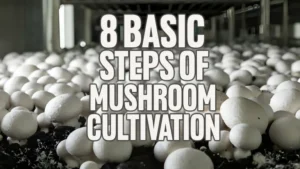








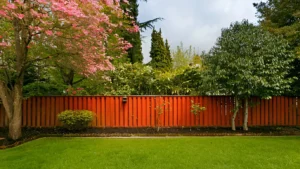

Leave your comment